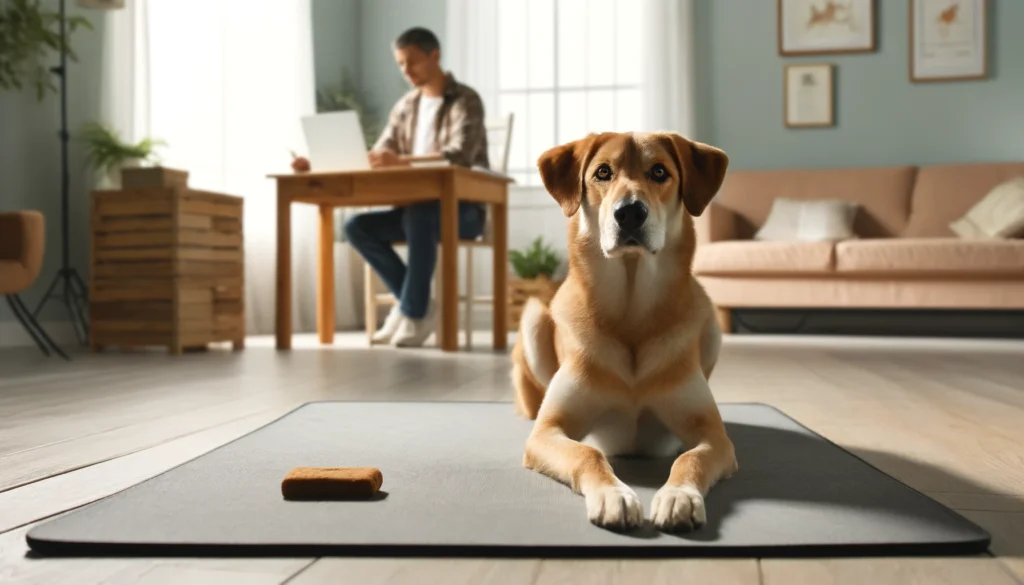Whether you live in a small apartment or a house full of activity, one of the most useful skills you can teach your dog is how to “settle.” This means calmly lying down and staying relaxed without constant stimulation or instruction — an invaluable behavior for working from home, hosting guests, or managing high-energy dogs in tight indoor spaces.
In this guide, you’ll learn how to teach your dog to settle on command, reinforce calm behavior, and turn overstimulating environments into peaceful routines.
What Does “Settle” Really Mean?
“Settle” is different from “sit” or “stay.” It doesn’t require alertness or waiting for the next cue — it’s about encouraging your dog to truly relax.
A well-trained settle looks like:
- Lying down on a mat or spot
- Head down, breathing slowed
- Calm, neutral energy
- Remaining in place for several minutes or more
Teaching this behavior helps dogs self-regulate in high-energy or uncertain situations — from doorbells to dinner parties.
Why Teaching Settle Matters Indoors
Indoor life can be overstimulating or boring, depending on your dog’s energy level. Settle training helps by:
- Reducing hyperactivity or anxious pacing
- Teaching your dog how to “turn off”
- Preventing jumping, barking, or attention-seeking
- Supporting crate training or independent relaxation
- Making your daily routine easier (meals, work, calls, guests)
It’s one of the best ways to turn energy into emotional balance.
What You’ll Need
- A soft mat, bed, or towel (used only for settle training)
- High-value treats (small and soft)
- A quiet space without distractions
- Patience and consistency
You can train in short 5–10 minute sessions, once or twice a day.
Step-by-Step: Teaching the Settle Command
Step 1: Introduce the Mat
- Place the mat on the floor in a calm space
- Lure your dog onto it with a treat
- The moment they step on it, mark (“yes!” or click) and reward
- Repeat until your dog goes to the mat easily
You’re building a positive association with the mat — it’s their “calm zone.”
Step 2: Encourage Lying Down
- Once your dog is comfortable on the mat, ask for a “down”
- If they don’t know the cue, lure them into a lying position
- Mark and reward as soon as elbows hit the floor
- Keep rewards low and calm — don’t excite them again
Start adding a verbal cue like “settle” once they’re lying down reliably.
Step 3: Reward Calmness, Not Just Position
- Watch your dog’s body language — relaxed head, slow breathing, floppy posture
- Give treats for moments of true calm, not just staying down
- Space out rewards gradually (every few seconds, then every 30+ seconds)
- Speak softly and keep energy low
Avoid hyping them up — settling means relaxing, not waiting for action.
Step 4: Build Duration and Distance
- Once your dog can settle for 1–2 minutes, begin standing up or walking a few steps away
- Return and reward if they stay settled
- Practice while you do simple tasks like checking your phone or folding laundry
- Eventually, increase duration up to 10–20 minutes during quiet times
Keep sessions short and success-based. End before your dog gets restless.
Step 5: Add Distractions Gradually
After success in quiet settings, start adding light distractions:
- TV or music playing in the background
- Guests entering from a distance
- Moving between rooms or using the vacuum nearby
Reward for calm behavior despite stimulation. If your dog breaks, reset gently and reduce distraction.
When and Where to Use the Settle Cue
Once your dog understands “settle,” you can use it in real-life situations like:
- During meals or cooking
- While working or in meetings
- When someone rings the doorbell
- At the vet or groomer
- Before bedtime or after a walk
Consistency makes the cue stronger. The more often you use it in context, the faster your dog will generalize the skill.
Common Mistakes to Avoid
Rewarding alertness instead of calm: Wait for relaxed posture, not just lying down.
Using it during peak energy moments: Teach after exercise or play, not when your dog is wound up.
Forcing the behavior: Use positive reinforcement, not physical placement or restraint.
Inconsistency: Practice daily to reinforce the routine and prevent regression.
Supporting Calm Behavior Outside of Training
Complement settle training with:
- Daily physical exercise
- Interactive feeding (puzzle toys, snuffle mats)
- Chew toys for decompression
- A consistent routine and quiet rest space
These elements create a lifestyle that naturally encourages settling.
From Overactive to Zen
Training your dog to settle doesn’t just make your life easier — it gives your dog the tools to manage their own energy, navigate chaos, and stay emotionally balanced indoors.
In time, they’ll learn that calm behavior brings comfort, reward, and connection — no matter what’s happening around them.






